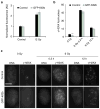Numerical chromosomal instability mediates susceptibility to radiation treatment
- PMID: 25606712
- PMCID: PMC4516720
- DOI: 10.1038/ncomms6990
Numerical chromosomal instability mediates susceptibility to radiation treatment
Abstract
The exquisite sensitivity of mitotic cancer cells to ionizing radiation (IR) underlies an important rationale for the widely used fractionated radiation therapy. However, the mechanism for this cell cycle-dependent vulnerability is unknown. Here we show that treatment with IR leads to mitotic chromosome segregation errors in vivo and long-lasting aneuploidy in tumour-derived cell lines. These mitotic errors generate an abundance of micronuclei that predispose chromosomes to subsequent catastrophic pulverization thereby independently amplifying radiation-induced genome damage. Experimentally suppressing whole-chromosome missegregation reduces downstream chromosomal defects and significantly increases the viability of irradiated mitotic cells. Further, orthotopically transplanted human glioblastoma tumours in which chromosome missegregation rates have been reduced are rendered markedly more resistant to IR, exhibiting diminished markers of cell death in response to treatment. This work identifies a novel mitotic pathway for radiation-induced genome damage, which occurs outside of the primary nucleus and augments chromosomal breaks. This relationship between radiation treatment and whole-chromosome missegregation can be exploited to modulate therapeutic response in a clinically relevant manner.
Conflict of interest statement
Figures






References
-
- Gunderson LL, Tepper JE. Clinical Radiation Oncology. Churchill Livingstone; 2011.
-
- Glass WA, Varma MN. Physical and Chemical Mechanisms in Molecular Radiation Biology. Springer; 2012.
-
- Chapman JR, Taylor MRG, Boulton SJ. Playing the end game: DNA double-strand break repair pathway choice. Mol Cell. 2012;47:497–510. - PubMed
Publication types
MeSH terms
Grants and funding
- R01 NS080619/NS/NINDS NIH HHS/United States
- P01 CA118816/CA/NCI NIH HHS/United States
- L60 MD001952/MD/NIMHD NIH HHS/United States
- R01NS080619/NS/NINDS NIH HHS/United States
- R37GM051542/GM/NIGMS NIH HHS/United States
- P30 CA023108/CA/NCI NIH HHS/United States
- R01 CA164746/CA/NCI NIH HHS/United States
- R01GM008704/GM/NIGMS NIH HHS/United States
- R37 GM051542/GM/NIGMS NIH HHS/United States
- T32 GM008704/GM/NIGMS NIH HHS/United States
- R01CA164746/CA/NCI NIH HHS/United States
- R01CA120205/CA/NCI NIH HHS/United States
- R01 CA120205/CA/NCI NIH HHS/United States
LinkOut - more resources
Full Text Sources
Other Literature Sources
Medical

